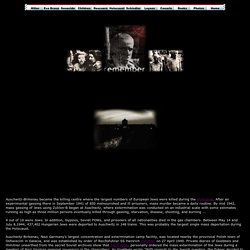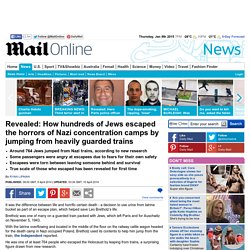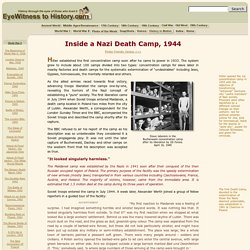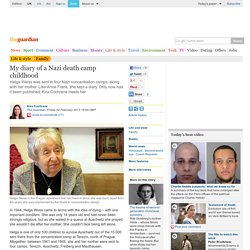

Nazi death camp. Auschwitz-Birkenau became the killing centre where the largest numbers of European Jews were killed during the Holocaust.

After an experimental gassing there in September 1941 of 850 malnourished and ill prisoners, mass murder became a daily routine. By mid 1942, mass gassing of Jews using Zyklon-B began at Auschwitz, where extermination was conducted on an industrial scale with some estimates running as high as three million persons eventually killed through gassing, starvation, disease, shooting, and burning ... 9 out of 10 were Jews. In addition, Gypsies, Soviet POWs, and prisoners of all nationalities died in the gas chambers. Between May 14 and July 8,1944, 437,402 Hungarian Jews were deported to Auschwitz in 148 trains. Auschwitz-Birkenau, Nazi Germany's largest concentration and extermination camp facility, was located nearby the provincial Polish town of Oshwiecim in Galacia, and was established by order of Reichsfuhrer SS Heinrich Himmler on 27 April 1940.
Josef Mengele "Dr. Children during the Holocaust. Children were especially vulnerable in the era of the Holocaust.

The Nazis advocated killing children of “unwanted” or “dangerous” groups in accordance with their ideological views, either as part of the “racial struggle” or as a measure of preventative security. The Germans and their collaborators killed children both for these ideological reasons and in retaliation for real or alleged partisan attacks. The Germans and their collaborators killed as many as 1.5 million children, including over a million Jewish children and tens of thousands of Romani (Gypsy) children, German children with physical and mental disabilities living in institutions, Polish children, and children residing in the occupied Soviet Union. The chances for survival for Jewish and some non-Jewish adolescents (13-18 years old) were greater, as they could be deployed at forced labor. How hundreds of Jews escaped Nazi concentration camps. Around 764 Jews jumped from Nazi trains, according to new researchSome passengers were angry at escapees due to fears for their own safety Escapees were torn between leaving someone behind and survivalTrue scale of those who escaped has been revealed for first time By Ryan Lipman Published: 08:00 GMT, 9 April 2014 | Updated: 03:34 GMT, 10 April 2014 It was the difference between life and horrific certain death - a decision to use urine from latrine bucket as part of an escape plan, which helped save Leo Bretholz’s life.

Bretholz was one of many on a guarded train packed with Jews, which left Paris and for Auschwitz on November 5, 1943. With the latrine overflowing and located in the middle of the floor on the railway cattle wagon headed for the death camp in Nazi occupied Poland, Bretholz used its contents to help him jump from the train, the Independent reported. He was one of at least 764 people who escaped the Holocaust by leaping from trains, a surprising figure drawn from new research. Inside a Nazi Death Camp, 1944.
Inside a Nazi Death Camp, 1944 Hitler established the first concentration camp soon after he came to power in 1933.

The system grew to include about 100 camps divided into two types: concentration camps for slave labor in nearby factories and death camps for the systematic extermination of "undesirables" including Jews, Gypsies, homosexuals, the mentally retarded and others. As the allied armies raced towards final victory, advancing troops liberated the camps one-by-one, revealing the horrors of the Nazi concept of establishing a "pure" society. The first liberation came in July 1944 when Soviet troops entered Maidanek, a death camp located in Poland two miles from the city of Lublin. Alexander Werth, a correspondent for the London Sunday Times and the BBC, accompanied the Soviet troops and described the camp shortly after its capture. The BBC refused to air his report of the camp as his description was so unbelievable they considered it a Soviet propaganda ploy. My diary of a Nazi death camp childhood. In 1944, Helga Weiss came to terms with the idea of dying – with one important condition.

She was only 14 years old and had never been strongly religious, but as she waited in a queue at Auschwitz she prayed she wouldn't die after her mother. She couldn't face being left alone. Helga is one of only 100 children to survive Auschwitz out of the 15,000 sent there from the concentration camp at Terezín, north of Prague. Altogether, between 1941 and 1945, she and her mother were sent to four camps: Terezín, Auschwitz, Freiberg and Mauthausen. The first was Terezín, where they spent three years, sleeping two or three to a bed that was really too small for one, with little to eat and to keep out the cold. She closes her eyes, and folds her arms tightly about herself.
We are in Helga Weiss's living room on the fourth floor of an apartment building in Prague. Helga was born in this flat and it has always been her home, apart from the four years she spent in Nazi concentration camps.